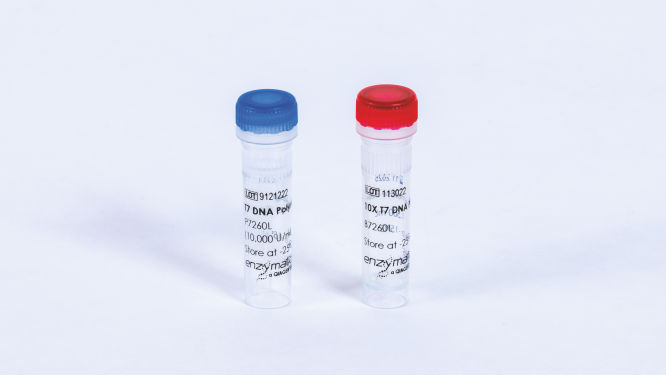Cat. No. / ID: P7260L
Features
- Powerful 3′→5′ exonuclease activity that acts on both single and double-stranded DNA
- Mesophilic, highly processive, replicative DNA Polymerase
Product Details
T7 DNA Polymerase is the mesophilic, highly processive, replicative DNA polymerase from bacteriophage T7 that is responsible for the rapid and accurate replication of the virus’ genome during its infection cycle. T7 DNA Polymerase is a two-subunit protein, consisting of a polymerase domain (gene 5 from the T7 bacteriophage) and a processivity factor (E. coli trxA gene thioredoxin) (1,2). The enzyme possesses a powerful (3′→5′) exonuclease activity that acts on both single and double stranded DNA and appears to be responsible for the high fidelity of this enzyme and prevents strand displacement synthesis (3,4,5).
T7 DNA Polymerase is a highly processive DNA polymerase with an exceptionally high synthesis and replication fidelity rate. The enzyme is supplied in 50 mM KPO4, 0.1 mM EDTA, 1.0 mM DTT and 50% glycerol; pH 7.0 at 25°C.
10X T7 DNA Polymerase Buffer (B7260) contains 400 mM Tris-HCl, 200 mM MgCl2 and 500 mM NaCl; pH 7.5 at 25°C.
Performance
- Storage temperature: –25°C to –15°C
- Molecular weight: 92,140 Daltons
| Test | Specification |
|---|---|
| Purity | >99% |
| Specific activity | 13,333 U/mg |
| Single-stranded exonuclease | Functional |
| Double-stranded exonuclease | Functional |
| Double-stranded endonuclease | 100 U, no conversion |
| E. coli DNA contamination | 100 U, <10 copies |
Principle
The recombinant enzyme protein is produced by a recombinant E. coli strain carrying the bacteriophage T7 gene 5.
One unit is defined as the amount of polymerase required to convert 10 nmol of total dNTPs into acid insoluble material in 30 minutes at 37°C.
Procedure
Usage Instructions
The following workflow can be applied to either second-strand synthesis following first-strand synthesis off an RNA template, or to a site-directed mutagenesis experiment where the mutagenic primer is extended such that the entire template strand is copied.
- In a sterile reaction vessel, combine the following components:
| Components | Final Concentration | Volume |
|---|---|---|
| Nuclease Free Water | N/A | 13.5 µL |
| Pre-annealed/template | 20 nmol complex | 20 µL |
| 10X DNA Pol Buffer (B7260) | 1X | 4 µL |
| 25 mM dNTP solution | 300 µM | 0.5 µL |
| T7 DNA polymerase (P7260L) | 500 U/mL | 2 µL |
| Total Volume = | 40 µL |
2. Incubate for 60 minutes at 37°C. Incubate for 10 minutes at 70°C to stop the reaction.
Note: This enzyme is not suitable for DNA sequencing.
Quality Control
Unit activity was measured using a twofold serial dilution method. Dilutions of the enzyme were made in 1X reaction buffer and added to 50 µL reactions containing calf thymus DNA, 1X T7 DNA Polymerase Unit Characterization Buffer (20 mM Tris-HCl, 100 mM KCl, 6 mM MgCl2, 0.1 mM EDTA, 5 mM β-mercaptoethanol), 3H-dTTP and 150 µM dNTPs. Reactions were incubated for 10 minutes at 37°C, placed on ice, and analyzed using the method of Sambrook and Russell (Molecular Cloning, v3, 2001, pp. A8.25-A8.26).
Protein concentration is determined by OD280 absorbance.
Physical purity is evaluated by SDS-PAGE of concentrated and diluted enzyme solutions followed by silver-stain detection. Purity is assessed by comparing the aggregate mass of contaminant bands in the concentrated sample to the band's mass corresponding to the protein of interest in the diluted sample.
Single-stranded exonuclease is determined in a 50 µL reaction containing a radiolabeled single-stranded DNA substrate and 10 µL of enzyme solution incubated for 4 hours at 37°C.
Double-stranded exonuclease activity is determined in a 50 µL reaction containing a radiolabeled double-stranded DNA substrate and 10 µL of enzyme solution incubated for 4 hours at 37°C.
Double-stranded endonuclease activity is determined in a 50 µL reaction containing 0.5 µg of plasmid DNA and 10 µL of enzyme solution incubated for 4 hours at 37°C.
E. coli contamination is evaluated using 5 µL replicate samples of enzyme solution that are denatured and screened in a TaqMan qPCR assay for the presence of contaminating E. coli genomic DNA using oligonucleotide primers corresponding to the 16S rRNA locus.
Applications
This product is available for molecular biology applications such as:
- Copying long stretches
- DNA manipulation
- Site-directed mutagenesis
- Second strand synthesis
- Gap filling reaction (no strand displacement)
- ISEL assay: apoptosis detection by in situ labeling of DNA breaks
References
1. Grippo, P., et al. (1971) J. Biol. Chem. 246:6867.
2. Modrich, P., et al. (1975) J. Biol. Chem. 250:5515.
3. Adler, S., et al. (1979) J. Biol. Chem. 254:11605.
4. Hori, K., et al. (1979) J. Biol. Chem. 254:11598.
5. Lechner, R.L.. et al. (1983) J. Biol. Chem. 258:11185.

